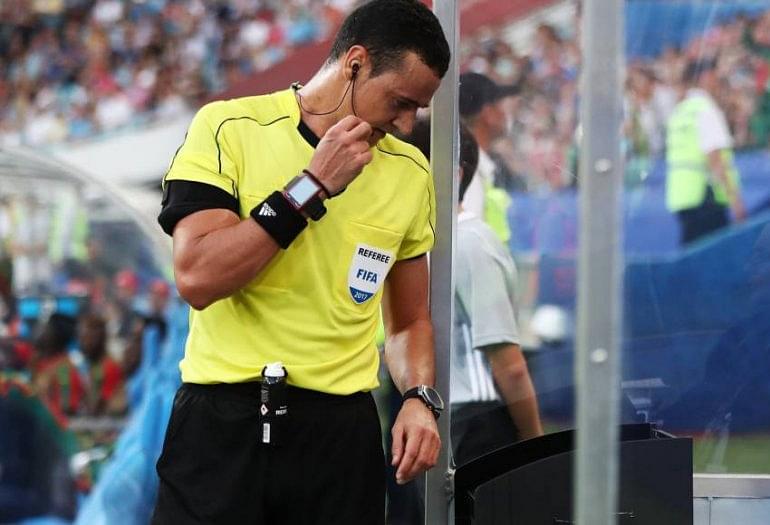VIDEO Assistant Referee (VAR) is a technology that has been designed to assist on-field referees in making the correct decision during the course of play. Many decisions can be pivotal and change the momentum and of the game.
It is but natural for on-field referees to miss certain moments in real-time, due to angles or the sheer speed of the game.
VARs are not currently part of the Laws of the Game, but their use is currently being trialled by the International Football Association Board in a number of competitions.
The official signal for a video review is by the referee making the outline of a rectangle with his index fingers (indicating a video screen). This precedes both any on-field reviews (OFR) as well as any change in the original call.
Players who demand a video review by making the rectangle motion are to be cautioned with a yellow card. Players who enter the area where the referee conducts an OFR are also to be cautioned with a yellow card, and team officials who do so are to be dismissed.
There are guidelines the referee and the VAR should follow in conducting a video review. For example, slow motion should only be used for “point of contact” offences, such as physical offences and handballs.
Regular speed should be used to determine the intensity of an offence and whether a handball was deliberate.
Reviews for goals, penalty kick decisions, and red cards for denial of an obvious goal scoring opportunity cover the period back to the beginning of the “attacking possession phase” (APP), when the attacking team first gained possession of the ball or restarted play. Other reviews only cover the incident itself.
The VAR will be either a current or former referee. The VAR may be located in the stadium where the match is being played or at another location.
A “pitch-side monitor” was introduced at the 2016 FIFA Club World Cup, allowing referees to review footage from the field.
Introduction of VAR
The A-League in Australia became the first to use a VAR system in a professional league game on 7 April 2017, when Melbourne City played Adelaide United. The game was completed without the VAR being called upon.
The first intervention by a VAR in a professional league game was seen on 8 April when Wellington Phoenix hosted Sydney FC. The VAR identified an illegal handball in the penalty area and awarded Sydney FC a penalty.
Major League Soccer in the United States introduced VARs in competitive matches during its 2017 season after the 2017 MLS All-Star Game on 2 August 2017.
Germany introduced the system during the 2017–18 Bundesliga and Italy in the 2017–18 Serie A.
The system was introduced in Portugal in 2017 in the 2016–17 Taça de Portugal final, afterwards in the 2017 Supertaça Candido de Oliveira and finally in the 2017-18 Primeira Liga. FIFA plans to debut the system at the 2018 FIFA World Cup.
The VAR is limited to four (4) kinds of incident, including goals, penalty decisions, red card incidents and mistaken identity.
Goals: The Role of the VARs is to assist the referee to determine whether there was an infringement that means a goal should not be awarded.
Penalty Decisions: The role of the VAR is to ensure that no clearly wrong decisions are made in conjunction with the award or non-award of a penalty kick.
Red Card Incidents: The role of the VAR is to ensure that no clearly wrong decisions are made in conjunction with sending off or not sending off a player.
Mistaken Identity: The referee cautions or sends off the wrong player, or is unsure which player should be sanctioned. The VARs will inform the referee so that the correct player can be disciplined.
How do video assistant referees (VARs) work?
The referee informs the VARs, or the VARs recommend to the referee that a decision/incident should be reviewed.
The video footage is reviewed by the VARs, who advise the referee via headset what the video shows.
The referee decides to review the video footage on the side of the field of play before taking the appropriate action/decision, or the referee accepts the information from the VARs and takes the appropriate action/decision.
What happened in the Chelsea v Arsenal Carabao Cup Match?
Chelsea questioned whether they should have had a penalty as Fabregas went over under Danny Welbeck’s challenge in the second half. The game went on and it was only when Chelsea won a corner was the VAR involved.
The rule states that the system can be called upon during stoppages in play only. Now this has many consequences.
What if Arsenal had scored a goal on the counter-attack? The VAR would have been called upon and if it had been a penalty, the Arsenal goal would have been cancelled and Chelsea would have been awarded a penalty.
With the VAR set to be used in the FIFA World Cup, the authorities would like to settle the debate and clear the air.
Overall, there has been good and bad moments for VAR – as it has come to be known – and it is sure to continue to be a talking point during the coming months.

